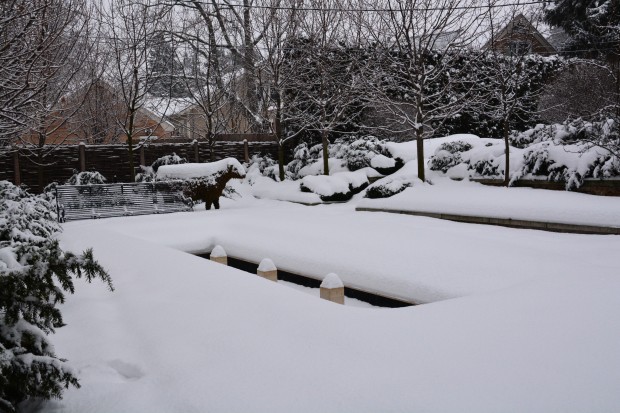 My friend Michael wrote me yesterday that the National Weather Service should have issued a “boxwood obliteration warning” along with all of their other communiques on our endless string of winter storms. I perfectly understand his irritation. We have had storm after storm, layered between bouts of very cold temperatures. This means the snow is piling up. The piles along my sidewalks are easily 6′ tall. Thick layers of snow are extremely heavy. My boxwood hedges are very densely twiggy, and seemed to be handling the weight with relative ease. But some select spots of those boxwood hedges are beginning to look alarmingly splayed open from the weight of the snow. Am I worrying-oh yes. Other shrubby plants are beginning to get that smothered and half strangled look. This observation having been made, I have always been a member of the do not touch group. Am I recommending that you do not touch a shrub going down from a load of snow? No. How you handle your garden is your business. What is to follow is a discussion of my experience. Do with that what you will.
My friend Michael wrote me yesterday that the National Weather Service should have issued a “boxwood obliteration warning” along with all of their other communiques on our endless string of winter storms. I perfectly understand his irritation. We have had storm after storm, layered between bouts of very cold temperatures. This means the snow is piling up. The piles along my sidewalks are easily 6′ tall. Thick layers of snow are extremely heavy. My boxwood hedges are very densely twiggy, and seemed to be handling the weight with relative ease. But some select spots of those boxwood hedges are beginning to look alarmingly splayed open from the weight of the snow. Am I worrying-oh yes. Other shrubby plants are beginning to get that smothered and half strangled look. This observation having been made, I have always been a member of the do not touch group. Am I recommending that you do not touch a shrub going down from a load of snow? No. How you handle your garden is your business. What is to follow is a discussion of my experience. Do with that what you will.
 My PJM rhododendrons have broad leaves, arranged in tufts atop slender branches. Heavy wet snow in 28 degree weather that sticks to those tufts usually slides off. But if the temps take a sudden dive, those wet greasy snowballs can harden and stick. A weighty iceball on the end of a long slender branch can prove very destructive. Every gardener in a northerly climate has seen damage to trees and shrubs from ice. I have a substantial dogwood branch that broke close to the main trunk last spring. The weight of the ice on the branches was enough to snap the branch, almost through. As for these PJMs, warmer weather will tell the tale. I feel quite sure if I were to try to dislodge this caked icy snow, I would damage the plants.
My PJM rhododendrons have broad leaves, arranged in tufts atop slender branches. Heavy wet snow in 28 degree weather that sticks to those tufts usually slides off. But if the temps take a sudden dive, those wet greasy snowballs can harden and stick. A weighty iceball on the end of a long slender branch can prove very destructive. Every gardener in a northerly climate has seen damage to trees and shrubs from ice. I have a substantial dogwood branch that broke close to the main trunk last spring. The weight of the ice on the branches was enough to snap the branch, almost through. As for these PJMs, warmer weather will tell the tale. I feel quite sure if I were to try to dislodge this caked icy snow, I would damage the plants.
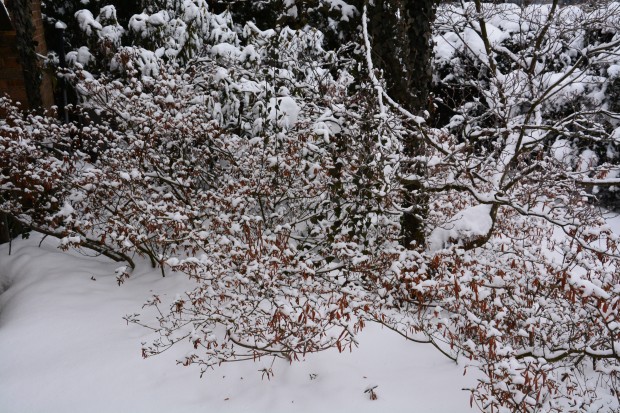 When snow buries both evergreen and deciduous shrubs, I have no worries. Snow is an insulator, a winter packing material of sorts. Most snow is light, and infills all of the spaces between the branches. But when heavy snow collects, freezes hard, and glues itself to the ends of branches that are not so hefty, an alarm goes off. Shall I brush the heavy snow off of the tips of my shrubs, or leave that snow be? Plants are tough, but maybe not tough enough in their already stressed circumstances to withstand a broom.
When snow buries both evergreen and deciduous shrubs, I have no worries. Snow is an insulator, a winter packing material of sorts. Most snow is light, and infills all of the spaces between the branches. But when heavy snow collects, freezes hard, and glues itself to the ends of branches that are not so hefty, an alarm goes off. Shall I brush the heavy snow off of the tips of my shrubs, or leave that snow be? Plants are tough, but maybe not tough enough in their already stressed circumstances to withstand a broom.
I do not plant even arborvitaes when the weather is right around freezing. The needles will surely brown wherever I touch them. I do not brush the snow off of any plant-especially when the temperature is really cold. I have always thought that my efforts to clear snow from my plants may do more harm than good. I am more inclined to back off, and wring my hands in private. Plants have an incredible will to live. I have a substantial broken dogwood branch that has been hanging on by a one inch wide piece of bark for better than a year. It is loaded with buds for spring. No matter how terrible the winter weather is, my inclination is to not intervene.
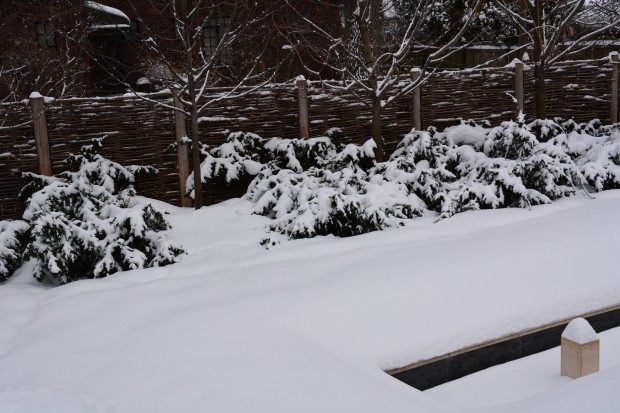 Snow cover which is frozen through and through is a tough coating to remove. Just tonight I was chopping ice on my deck with a shovel. I do not want to slip and fall-nor do I want my corgis to slip and strain a muscle. I am not a fan of ice anywhere in the travelled landscape, except as a last resort. Chopping the ice on a deck is a vastly different issue that brooming wet frozen snow from my yews. The densiformis yews pictured above have arms bent to the ground. I have no idea if those branches are bent to the breaking point. Branches are subject to all manner of insults from weather. Wind, sun scald-the scraping from my staking, the scale-branches endure assault year round. Should I broom the snow off of them? Could I damage the branches even more, if I interfere?
Snow cover which is frozen through and through is a tough coating to remove. Just tonight I was chopping ice on my deck with a shovel. I do not want to slip and fall-nor do I want my corgis to slip and strain a muscle. I am not a fan of ice anywhere in the travelled landscape, except as a last resort. Chopping the ice on a deck is a vastly different issue that brooming wet frozen snow from my yews. The densiformis yews pictured above have arms bent to the ground. I have no idea if those branches are bent to the breaking point. Branches are subject to all manner of insults from weather. Wind, sun scald-the scraping from my staking, the scale-branches endure assault year round. Should I broom the snow off of them? Could I damage the branches even more, if I interfere?
 Most of my boxwoods are buried in snow. Once a too heavy snow load falls to one side, and splits open a shrub, I am alarmed. Snow can be heavy enough to crack branches open. There can be fresh hell to pay in the spring. Cracked branches are an invitation to disease. A beloved boxwood hedge with a big dead section is enough to make any gardener weep. My advice? Do not intervene in the natural order of events, unless the need for intervention wakes you up in the middle of the night. If you must intervene, use a long bamboo pole-gently. Wait until the weather is close to, or above freezing. A branch frozen through and through is brittle. If you must remove excessive snow, tickle it off.
Most of my boxwoods are buried in snow. Once a too heavy snow load falls to one side, and splits open a shrub, I am alarmed. Snow can be heavy enough to crack branches open. There can be fresh hell to pay in the spring. Cracked branches are an invitation to disease. A beloved boxwood hedge with a big dead section is enough to make any gardener weep. My advice? Do not intervene in the natural order of events, unless the need for intervention wakes you up in the middle of the night. If you must intervene, use a long bamboo pole-gently. Wait until the weather is close to, or above freezing. A branch frozen through and through is brittle. If you must remove excessive snow, tickle it off.
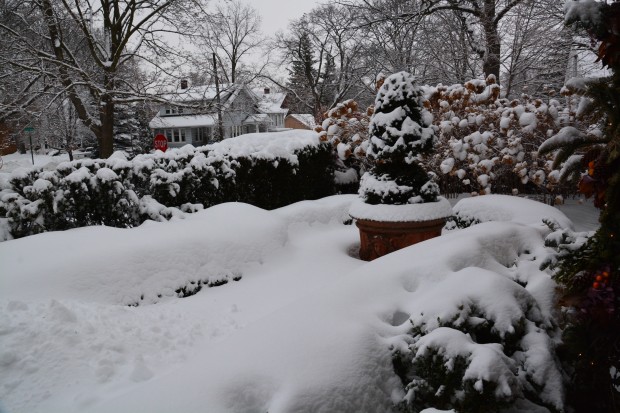 There are those that favor removing snow from shrubs. There are those that favor letting nature take its course. For the moment, I am standing pat. A good bit of my reason-I cannot really reach them anymore.
There are those that favor removing snow from shrubs. There are those that favor letting nature take its course. For the moment, I am standing pat. A good bit of my reason-I cannot really reach them anymore.
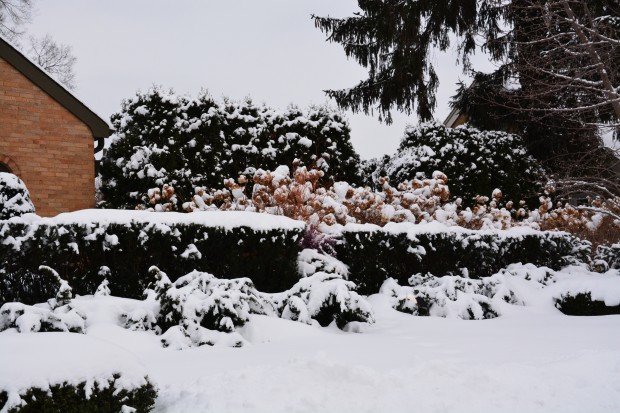 No matter the work that I do in my garden, I feel sure that each and every plant comes equipped with all the survival gear it needs. Nature has never needed much from me. I am believing these densiformis yews will spring back, once we have a decent melt. But there are those moments in a garden that warrant intervention. The trick is to judge the right time and circumstance.
No matter the work that I do in my garden, I feel sure that each and every plant comes equipped with all the survival gear it needs. Nature has never needed much from me. I am believing these densiformis yews will spring back, once we have a decent melt. But there are those moments in a garden that warrant intervention. The trick is to judge the right time and circumstance.
 Though I am not entertaining, planting, weeding, or watering right now, my garden is on my mind. Like the corgis, my garden cannot tell me where it hurts. I observe, and make my best call.
Though I am not entertaining, planting, weeding, or watering right now, my garden is on my mind. Like the corgis, my garden cannot tell me where it hurts. I observe, and make my best call.
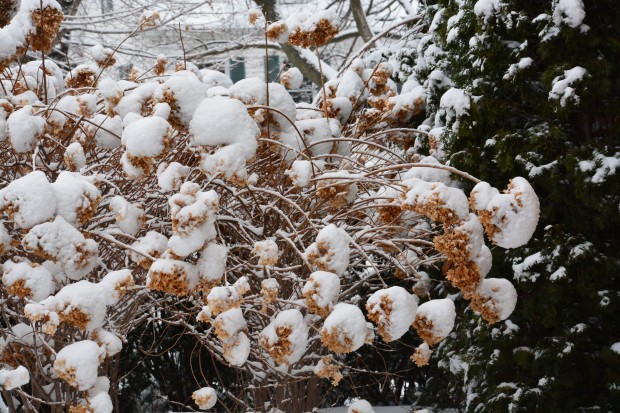 My winter weary shrubs – it is a worry. And we have more snow on the way.
My winter weary shrubs – it is a worry. And we have more snow on the way.
